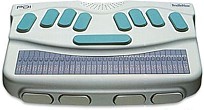Visual Disabilities
Blindness
How Blind People Use the Web
Although most blind people have some vision, it is seldom adequate to interact with web content. A monitor and mouse are essentially useless to a person who is blind. So then, just how do blind people use the web?
The key web accessibility principles for users who are blind are:
- Perceivable: visual information such as graphics, layout, or color-based cues cannot be perceived.
- Operable: the keyboard to is typically used to navigate and operate web content rather than a mouse
- Understandable: content must be presented in a way that preserves meaning and supports comprehension.
- Robust: content and web technologies must be compatible with assistive technologies, even if those technologies are not new.
Screen readers
Blind people can listen to, navigate, and interact with web content through screen reader software that converts web content into synthesized speech. The user can let the screen reader read everything from top to bottom, one line at a time, or the user can use the tab key to navigate through links and form controls. The user can also navigate via headings (if the web content has headings), from one page region to the next (if there are regions defined), or by various other methods. Smartphones and tablets come with built-in screen readers that allow touch and swipe gestures to navigate through content.
Common screen readers include JAWS, NVDA, and VoiceOver.
Screen readers can also be used by those who are both deaf and blind using a device that converts web page content into refreshable Braille rather than speech.

Devices such as this have small mechanical pins that can be raised or lowered to form Braille characters which the deaf-blind individual can feel.
Although screen readers cannot completely replicate the visual experience, most web content can be made highly accessible to screen reader users. Screen readers cannot analyze images to extract meaning. To convey the content or function of images, designers and developers apply alternative text to them. Similarly, a sighted user can scan a web page and quickly determine how the page is organized and make visual associations or differentiations between content based on layout, proximity, or visual design. Screen reader users can skip around and explore the content too, so long as site owners structure their pages logically and include semantically-correct code associations.
Keyboard accessibility
 Since screen reader users typically navigate the web with a keyboard, all functionality must be available through the keyboard. Buttons, widgets, or anything else that requires a mouse or touchpad/touchscreen must be avoided. This issue doesn't just affect screen reader users—some sighted users also rely on the keyboard due to motor disabilities or other reasons.
Since screen reader users typically navigate the web with a keyboard, all functionality must be available through the keyboard. Buttons, widgets, or anything else that requires a mouse or touchpad/touchscreen must be avoided. This issue doesn't just affect screen reader users—some sighted users also rely on the keyboard due to motor disabilities or other reasons.
